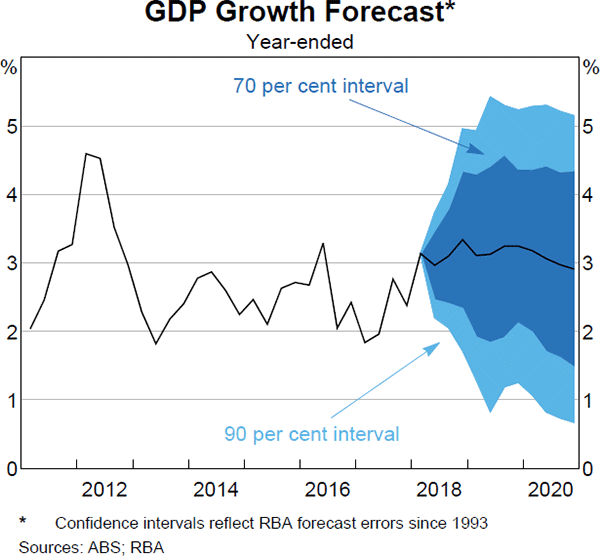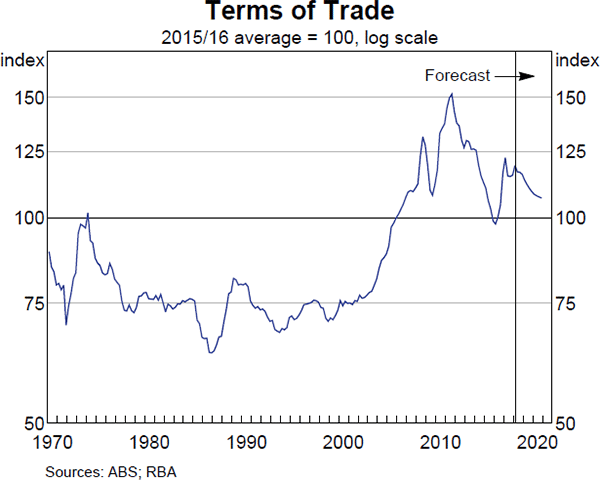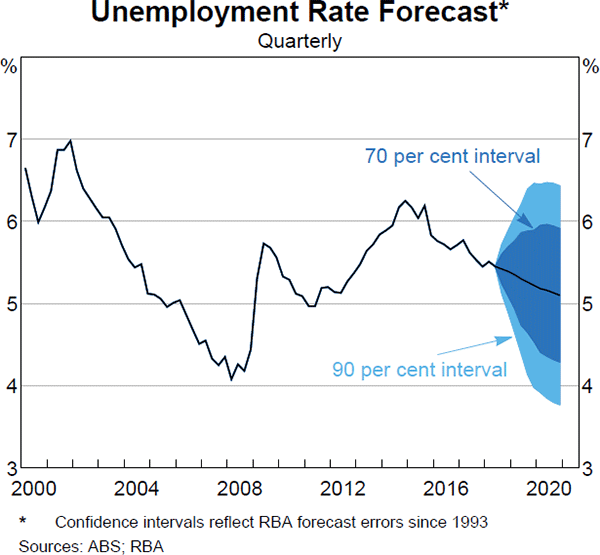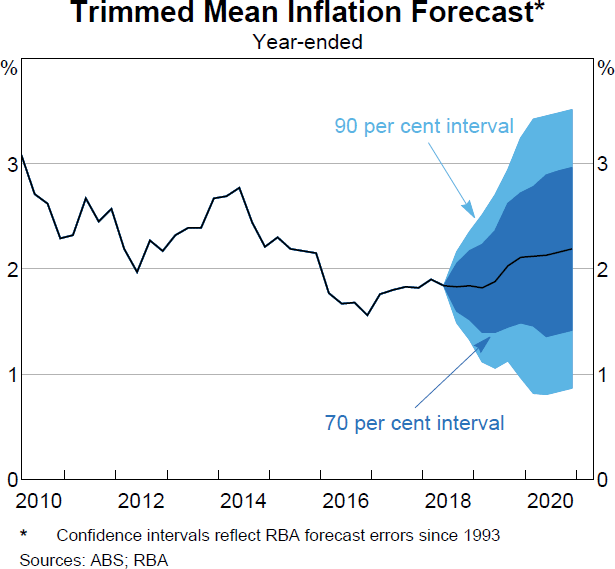Statement on Monetary Policy – August 2018 5. Economic Outlook
The forecasts for global and domestic growth are little changed from those presented in the May Statement on Monetary Policy. Domestic inflation is still expected to be 2¼ per cent in mid 2020, although inflation in the September quarter of this year is now expected to be lower because of declines in some administered prices.
Global economic growth has been solid and the outlook remains positive. While the risks to global growth from trade protection policies have increased, there are also other important uncertainties. A continuation of solid growth and further absorption of spare capacity – particularly in some major advanced economies – could result in inflation picking up more quickly than is currently expected. This would have implications for monetary policies and financial markets. There also continues to be uncertainty around the outlook for the Chinese economy, as the authorities there look to support growth while managing other objectives, such as financial stability. These risks are discussed below.
Domestic economic growth was a bit stronger than anticipated in the March quarter and is expected to remain above trend over the forecast period. As a result, the unemployment rate is forecast to decline gradually and this is expected to be associated with a further modest increase in wage and inflationary pressures. However, as discussed below, there continues to be uncertainty around the amount of spare capacity in the economy, how quickly it might decline and the consequences for inflation.
GDP growth is expected to remain above trend
GDP growth in Australia is expected to be above trend over the forecast period. Growth was stronger in the March quarter and quite broad based. Consumption growth moderated in the quarter, but was stable in year-ended terms. Partial indicators point to solid GDP growth in the June quarter and the year-ended rate is likely to remain a little above estimates of potential growth.
The forecasts for domestic output growth are broadly similar to those presented in the May Statement. GDP growth is forecast to be a little above 3 per cent over 2018 and 2019 (Table 5.1; Graph 5.1). Growth is then expected to ease to around 3 per cent in 2020 when the remaining liquefied natural gas (LNG) projects will have reached their targeted production levels and therefore no longer contribute to export growth.
Accommodative monetary policy and tighter labour market conditions are expected to provide ongoing support for growth in household income and consumption throughout the forecast period. Growth in non-mining business investment is expected to remain solid. The implementation of the National Disability Insurance Scheme (NDIS) and public infrastructure investment are expected to continue to boost public demand. Dwelling investment is expected to remain at high levels over the next year or so, supported by a significant pipeline of work still to be done, and then gradually decline towards the end of the forecast period. The economy is not expected to encounter broad-based capacity constraints for some time, although liaison contacts indicate that capacity constraints are affecting construction activity, particularly in Sydney, and there also continue to be difficulties attracting workers with specialised information technology skills.
| Year-ended | ||||||
|---|---|---|---|---|---|---|
| Jun 2018 | Dec 2018 | Jun 2019 | Dec 2019 | Jun 2020 | Dec 2020 | |
| GDP growth | 3 | 3¼ | 3¼ | 3¼ | 3 | 3 |
| Unemployment rate(b) | 5.5 | 5½ | 5¼ | 5¼ | 5¼ | 5 |
| CPI inflation | 2.1 | 1¾ | 2 | 2¼ | 2¼ | 2¼ |
| Underlying inflation | 2 | 1¾ | 2 | 2 | 2¼ | 2¼ |
| Year-average | ||||||
| 2017/18 | 2018 | 2018/19 | 2019 | 2019/20 | 2020 | |
| GDP growth | 2¾ | 3¼ | 3¼ | 3¼ | 3¼ | 3 |
|
(a) Technical assumptions include A$ at US$0.74, TWI at 64 and Brent crude oil price at US$73 per barrel; shaded regions are historical data Sources: ABS; RBA |
||||||

The domestic forecasts are conditioned on the technical assumptions that the cash rate evolves broadly in line with market expectations, which is for no change until at least the end of next year. The exchange rate and oil prices are assumed to remain at their current levels. This implies a trade-weighted exchange rate that is around 2½ per cent higher than was assumed in the May Statement, and a US dollar price of Brent crude oil that is around 2 per cent higher. The population aged 15 years and over is assumed to grow by 1.6 per cent per annum over the next few years.
Ongoing solid growth in non- mining investment is anticipated …
Non-mining business investment grew by 10 per cent over the year to the March quarter, led by non-residential construction. While leading indicators suggest that growth in construction activity will moderate over the next year, growth in machinery & equipment investment is expected to pick up further over the forecast period, consistent with an ongoing economic expansion.
The overall outlook for mining investment remains little changed: the trough in mining investment is still expected to occur in late 2018 or early 2019. The quarterly profile over the next year has been adjusted slightly to incorporate new information about additional spending associated with the completion of the remaining LNG projects. However, there is still some uncertainty around the timing of these outlays. Further out, mining investment is expected to increase moderately to sustain higher levels of production; recent company announcements have removed some uncertainty around the timing of this activity.
Public demand is expected to provide an ongoing impetus to growth. Liaison contacts continue to report that there are positive spillovers from strong growth in public infrastructure investment. Public demand is likely to be supported by additional revenues associated with the stronger-than-expected terms of trade, although this may be offset to some extent by lower stamp duty revenues associated with easing housing market conditions in some states.
… and the current rate of consumption growth is expected to continue
The forecasts for consumption growth are little changed. Consumption growth has been a bit more volatile from quarter to quarter over the past year, but has been stable in year-ended terms and is expected to continue at a similar rate. The March quarter outcome was lower than had been expected at the time of the May Statement, although the weakness was concentrated in expenditure on recreational services and hotels, cafes and restaurants and does not appear to have significant implications for the outlook; growth in consumption of goods remained strong in the quarter. The outlook for household consumption growth continues to represent a significant uncertainty for the forecasts, in large part due to uncertainty around household income growth (see below).
Household disposable income growth will be supported over the forecast period by the reductions in income taxes announced in the 2018/19 federal budget. Consumption is projected to grow at the same rate as household disposable income over the forecast period.
Exports are expected to continue growing, but with some change in composition
Exports are expected to grow strongly, led by LNG exports as production ramps up. Iron ore exports are expected to increase only slightly, supported by productivity improvements, and coal exports are expected to increase marginally. Non-ferrous metal exports are also likely to contribute to export volume growth (see ‘Box C: Outlook for Non-ferrous Metal Exports’). However, by 2020, most of Australia's major resource projects are expected to be producing at their targeted production levels. At this time, resource export volumes will be at historically high levels but will contribute little to GDP growth. Exports of services and manufactures are expected to grow steadily, supported by solid trading partner growth. Beyond the June quarter, rural exports are expected to be a little weaker than anticipated in the May Statement because of drought conditions in parts of the country. If these conditions were to persist or become more widespread, then the impact on rural exports, and the farm sector more generally, would be larger.
The terms of trade are still expected to moderate
Australia's terms of trade forecast has been revised a little higher relative to the May Statement, reflecting the recent strength in coal prices. The terms of trade are expected to remain around these higher levels for the next few quarters or so, before gradually declining over the medium term as Chinese demand for bulk commodities moderates and the global supply from low-cost producers increases (Graph 5.2). The terms of trade are expected to remain above their recent trough in early 2016.
It is possible that thermal coal prices will be higher than expected over the medium term. Government policies in a range of economies are encouraging a global transition to less carbon-intensive energy sources, which has meant that there has been little additional supply. However, the transition to alternative energy sources has been gradual and thermal coal power generation is expected to remain a material share of global energy production for some time, thereby supporting thermal coal prices.

Spare capacity in the labour market is expected to decline …
There has been little change to the labour market forecasts. Leading indicators of labour demand suggest employment will grow at an above-average pace over the second half of the year, albeit slower than the very strong growth recorded over 2017. With GDP growth expected to be above trend, employment growth is expected to be a little above the average growth in the working-age population over the next couple of years. These positive labour market conditions are expected to encourage more people to either enter or delay leaving the labour force and, as such, the participation rate is expected to rise a little further. The unemployment rate is expected to decline gradually over the forecast period to around 5 per cent by the end of 2020 (Graph 5.3); this rate is consistent with conventional estimates associated with full employment. However, there is uncertainty around estimates of spare capacity in the labour market (see below).

… which is expected to underpin a gradual pick-up in wages growth
The outlook for wages is little changed from the May Statement. Wages growth is expected to be boosted slightly in the near term as a result of the 3.5 per cent increase in award and minimum wages from 1 July. Further out, the pick-up in wages growth is expected to be gradual, consistent with information from the Bank's liaison program and the expectation of a steady decline in labour market spare capacity. Wage outcomes from enterprise bargaining agreements are likely to remain a drag on overall wages growth because wages growth in new agreements, despite having picked up recently, remains below that in current agreements. How much a pick-up in wages growth will add to inflationary pressures will depend on whether there is an accompanying increase in productivity growth.
Inflation is expected to pick up to above 2 per cent
The June quarter inflation outcomes were in line with the forecasts in the May Statement. However, the forecasts for headline and underlying inflation in the September quarter have been revised down. This is due to declines in the prices of some administered services that are known to have taken place in the quarter. This includes changes to the child care subsidy package, a decline in electricity and gas prices in some states, and some smaller changes to TAFE fees and car registration fees in New South Wales. There is uncertainty around the size of some of these price declines. The central forecast assumes that these price changes are one-offs and will not affect quarterly inflation in subsequent quarters.
The declines in administered prices are expected to have a larger effect on headline inflation than underlying inflation in the September quarter; in year-ended terms, both are now expected to be around 1¾ per cent in the second half of 2018 (Graph 5.4). Headline and underlying inflation are then expected to increase gradually to 2¼ per cent by mid 2020, which is unchanged from the May Statement. The increase reflects the expected decline in spare capacity in the economy.

The risks to the outlook have evolved
Domestically, there continues to be uncertainty about the degree of spare capacity in the labour market and how quickly that might be absorbed by above-trend growth. From the perspective of the inflation forecasts, there continues to be uncertainty about how quickly tighter labour market conditions will translate into wage pressures, and when competitive pressures in the retail sector might abate. Uncertainty about wages growth also translates into uncertainty about household disposable income, which is an important driver of the consumption outlook. Other uncertainties that affect the outlook for inflation, such as the size and persistence of changes in administered prices, also have implications for real disposable income.
The risks to global growth from trade protectionism have increased. In light of this, and recent policy actions by Chinese authorities to manage financial risks and slowing growth, there is uncertainty about the outlook for China, which is a key trading partner for Australia. However, growth in the United States could be stronger than expected, which would boost global growth. A depreciation of the trade-weighted Australian dollar, in an environment of US dollar strength, would also be positive for the domestic outlook for growth and inflation.
There is uncertainty about how much spare capacity there is in the economy
Leading indicators suggest that employment will continue to grow faster than the working-age population. However, it is unclear whether the increase in labour demand will be met by those who are currently unemployed finding jobs (which would lead to a reduction in the unemployment rate), those who are currently employed working more hours, or an increase in the participation rate. It is possible that the forecast for above-trend GDP growth over the next few years will result in a sharper decline in the unemployment rate than expected, which could lead to a stronger pick-up in wages growth than forecast.
There is also uncertainty about the level of the unemployment rate that is consistent with stable inflation, which has to be inferred. International experience suggests that these estimates may decline as the unemployment rate falls. If so, upward pressure on wages growth could be less than expected.
For some time, wage outcomes have been systematically lower than historical relationships with labour market spare capacity would suggest. This raises the possibility that structural changes, possibly related to technological change and competition, have been placing additional downward pressure on wages growth. From a forecasting perspective, it is difficult to gauge the effect these forces might have on wages growth over the next few years. It may also be the case that wages growth picks up faster than forecast after a sustained period of low wages growth.
With GDP growth expected to be above trend over the next couple of years, spare capacity is expected to decline in the economy more broadly. As such, firms are likely to face increasingly binding capacity constraints. Following a prolonged period of underinvestment (particularly in machinery & equipment), and with survey measures of capacity utilisation already well above average, it is possible that firms will increase investment expenditure by more than is currently embodied in the central forecast.
The outlook for administered prices and retail competition is unclear
The forecasts incorporate a temporary step-down in inflation in the September quarter based on known changes in some administrative prices. There is uncertainty about the size of some of these price declines, particularly in the case of the changes to child care subsidies. It is also the case that there may be larger-than-expected price increases in some expenditure categories during the quarter that are less apparent. However, there is a risk of further declines in administered prices in early 2019: there are a number of known government policy changes that take effect early next year, including new subsidies for children's extracurricular activities in New South Wales, changes to TAFE fees and the removal of caps for child care rebates.
There is also uncertainty about future movements in the prices of utilities. Utilities prices contributed 0.4 percentage points to headline inflation over the past year, but could decline or remain fairly steady over the forecast period. Wholesale electricity prices have already declined and the large volume of new renewable energy generation expected to come on line may put further downward pressure on wholesale prices. There is also uncertainty around other drivers of utilities prices, including the outlook for regulated network costs, which make up a significant share of the residential electricity bill, and the strength of competitive pressures in the retail energy market for new customers.
More generally, the forecasts assume that competition will continue to put downward pressure on a range of retail prices, particularly consumer durables. However, it is possible that the process of adjusting margins to the new level of retail competition will run its course over the forecast period and downward pressure on prices will abate.
The outlook for consumption remains uncertain
Uncertainty about the outlook for wages growth has a direct bearing on the forecasts for household income growth and therefore consumption. The changes to income tax announced in the 2018/19 federal budget should support growth in household disposable income over the forecast period. Lower administered prices may also support real income growth in the near term, given that administered items make up around one-fifth of household consumption. Other uncertainties that affect the outlook for inflation, such as the level of retail competition, also have implications for real disposable income.
The high level of household debt also remains a key consideration for household consumption. For example, a highly indebted household facing weaker growth in disposable income or wealth than they had expected may respond by reducing consumption. Consumption growth may also be lower for a time if households concerned about their debt levels choose to pay down debt more quickly rather than consume out of additional income. Steps taken by regulators to strengthen household balance sheets have led to a moderation in growth in the riskier types of lending to households, but risks remain. While demand factors are likely to have been the dominant influence affecting credit growth of late, the ongoing high level of public scrutiny of lending decisions could see some further tightening in the supply of credit, although there are no signs of this as yet.
Recent declines in national housing prices have been gradual and follow several years of very strong growth. Accordingly, there is no evidence that moderate housing price declines have weighed on household consumption to date. Nevertheless, housing assets account for around 55 per cent of total household assets, so lower housing prices could lead to lower consumption growth than is currently forecast. Although the earlier gains in national housing wealth may not have encouraged much additional consumption, it is possible that the consumption decisions of highly indebted and/or credit-constrained households could be more sensitive to declines in housing prices than to the previous increases.
Trade protectionism risks have increased
While the international outlook is largely unchanged from the May Statement, the risks to global growth from trade protectionism have increased. The direct impact on global GDP growth of the measures implemented so far is expected to be small, because the affected goods are only a small share of global trade; however, the growth forecasts for some more trade-exposed economies, such as Korea, have been scaled back a little. The risk is that an increase in protectionist measures could materially weaken the investment outlook and may weigh on confidence and financial market conditions more generally. Quantifying these possible effects is difficult at this point.
US growth could be stronger than expected
Global financial conditions remain supportive of growth, despite monetary policy in the United States becoming somewhat less accommodative against the backdrop of stronger growth and higher inflation in the US economy. The US economy is experiencing a substantial fiscal stimulus, which is unusual at a time of full employment. US growth could therefore be stronger than expected and spare capacity, which has already been largely absorbed, could decline further. It is also possible that the US government increases the fiscal stimulus by more than is currently legislated. Stronger US growth would provide a boost to global growth. US inflation could also increase by more than expected to be above the Federal Reserve's inflation goal. Under these conditions, the Federal Reserve would be likely to increase the federal funds rate by more, or more quickly, than currently anticipated.
Changes to the expected path of US monetary policy would be associated with significant financial market repricing, including an appreciation of the US dollar. The Australian dollar would be expected to depreciate against the US dollar, but the effect on Australia's trade-weighted exchange rate would depend on how far the exchange rates of other trading partners depreciate against the US dollar. In this environment, stronger global demand and a broad-based depreciation of the Australian dollar would be likely to boost growth in domestic activity and tradables inflation.
Chinese authorities continue to balance financial risks against growth
Chinese policymakers face several trade-offs that present risks to the outlook for the Chinese economy, demand for bulk commodities and thus Australia's terms of trade. Financial policy settings have generally been tightened over the past year, which has slowed the build-up of financial stability risks, but has also weighed on economic growth at a time when momentum is already easing for structural reasons. The moderation in growth has led the government to ease fiscal policy and bolster liquidity in a targeted way. Although some policy easing in response to weaker conditions had been anticipated, these changes could result in growth being a little higher than forecast in the second half of 2018 and early 2019. On the other hand, if additional fiscal spending is mainly financed by debt, it could undermine efforts to control overall leverage, resulting in a tightening of policy and weaker-than-expected economic growth further out. Chinese exchange rate policy presents a further source of uncertainty for the forecasts. If rising trade tensions and a more subdued growth outlook place further downward pressure on the renminbi, and the authorities allow a depreciation to occur, that could help offset weakness in parts of the economy.